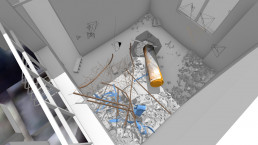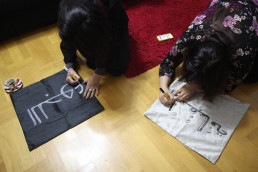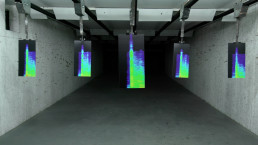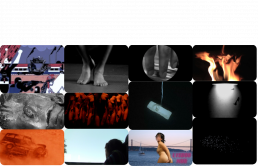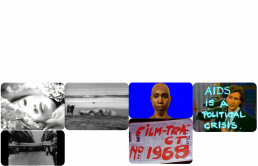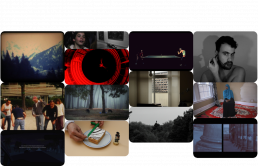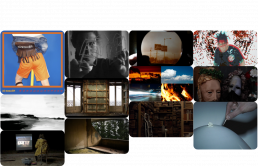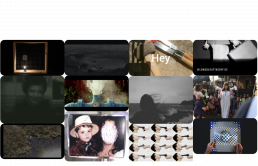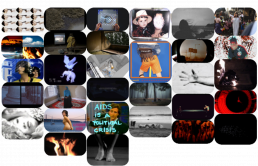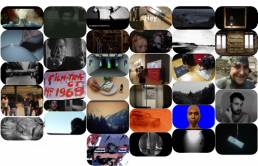“FUSO 2018 – 27 Agosto a 2 Setembro“
2 Setembro, 22h
Museu da Marioneta
Quando desconstruímos algo
Curadoria de Reem Fadda
Duração da sessão 69’
Este programa de filmes investiga os conceitos da descolonização, investigação forense, desconstrução e objetivo através do vídeo. De que forma os artistas desenvolveram uma linguagem de filmografia que utiliza o vídeo para apoiar uma ação em contextos humanitários, sociais e políticos? Os vídeos documentais já há muito que suportam o potencial de testemunho, mas será que podem, na realidade, tornar-se testemunhas, testemunhos, provas? De que forma os artistas e criativos usam o método do vídeo para fazer perguntas e fornecer uma ferramenta de eficácia na atualidade? Este programa inicia-se, de forma enigmática, com o vídeo artístico de Shuruq Harb, que questiona as linguagens da verdade e normalidade através dos espelhos dos anos de juventude na Guerra do Golfo, a Intifada e a chocante cultura underground da música trance em Telavive. Este programa é fortemente inspirado por uma citação de um texto desta obra, que dá o nome à sessão. O programa continua com o trabalho de Forensic Architecture e apresenta um estudo de caso do seu trabalho, Ataque com armas químicas em Douma, Síria, e como desenvolveram a linguagem da arquitetura e investigação forense usando vídeos públicos para criar provas usadas em casos de direitos humanos, a disseminação da verdade e até em tribunais. De seguida, o programa apresenta a obra de Sandi Hilal, membro do DAAR que tem trabalhado em diversas questões relacionadas com refugiados, da Palestina a Boden, na Suécia. Neste filme documentado por Ana Naomi De Sousa, regista os inícios de um projeto vital, The Living Room ou The Madhafah, no qual os refugiados reclamam os seus direitos a refugiarem-se num outro país. O quarto vídeo documenta a obra pertinente de MTL Collective, criado em Nova Iorque por Nitasha Dhillon e Amin Husain, com impacto na Palestina, Istambul, São Paulo e Londres. O seu objetivo era criar um coletivo artístico político focado na proliferação de ações diretas, de forma a impor ideias de resistência e formação na prática da liberdade. O vídeo final, do artista Lawrence Abu Hamdan, apresenta uma análise sonora pertinente às balas, provando que o exército israelita tinha como alvo dois rapazes palestinianos, numa demonstração nos arredores de Ramallah. Este vídeo é apresentado num formato abstrato através de um processo judicial, no qual esta análise sonora foi apresentada como prova.
Shuruq Harb (PLE), The White Elephant, 2018, 12’
Usando imagens partilhadas na Internet por israelitas durante a Guerra do Golfo, a Primeira Intifada e encontros de música trance, Shuruq Harb compõe o retrato de um adolescente palestiniano nos anos 90, no espelho da cultura pop israelita.
Forensic Architecture (UK), Chemical weapons attack in Douma, Syria, 2018, 9’19’’
A 7 de abril de 2018, a cidade síria de Douma foi alegadamente alvo de dois ataques com armas químicas. Nesse momento, a cidade e zonas circundantes encontravam-se cercadas por militares sírios desde 2013. Pelo menos 70 pessoas morreram nos ataques, de acordo com as informações disponibilizadas. Dois recipientes amarelos distintos, semelhantes aos previamente associados aos ataques com cloro gasoso em toda a Síria, foram encontrados após os ataques.
Dias depois, após as negociações de cessar fogo entre as restantes forças rebeldes em Douma, os meios de comunicação russos foram os primeiros a ter acesso aos locais do ataque. Os jornalistas da RT e TV Zvezda rapidamente afirmaram que os ataques tinham sido encenados.
Encomendado por e trabalhando de perto com o New York Times, a Forensic Architecture pesquisou provas físicas relacionadas com a forma como os recipientes chegaram a cada cenário, fornecendo uma análise que apoia a teoria de que os recipientes foram deitados por via aérea.
Ana Naomi de Sousa (UK), Living Room, 2018, 11’20’’
A arquiteta palestiniana Sandi Hilal explora o direito ao refúgio na região a norte de Norbotten, próxima do Círculo Polar Ártico, para onde a Suécia está agora a enviar diversos refugiados. Como podem simples atos de hospitalidade sabotar a dinâmica de poder entre refugiados e as suas comunidades anfitriãs? Uma curta metragem que explora não aquilo que foi deixado para trás, mas aquilo que os recém-chegados trazem com eles.
O documentário foi produzido dentro do contexto de uma instalação artística pela Sandi Hilal (DAAR) e foi apresentado e apoiado por ArkDes, Estocolmo 2018.
Produção Black Leaf Films
Financiamento Public Art Agency Sweden, AFAC
MTL Collective (UK), Practice in the Training of Freedom, 2017, 15’
Training in the Practice of Freedom explora ações que envolvem organizações como Black Lives Matter, Global Ultra Luxury Faction, Direct Action Front for Palestine e Decolonize This Place e instituições culturais nas quais a teoria e investigação, a ação e a estética, a organização e análise são implementadas para facilitar os espaços descoloniais para formação na prática da liberdade. O interesse reside em encontrar melhores soluções para os nossos movimentos e lutas, e os processos em curso.
Lawrence Abu Hamdan (JOR), Rubber Coated Steel, 2016, 21’49’’
Maio de 2014: dois adolescentes palestinianos desarmados são mortos por soldados israelitas na Cisjordânia. Abu Hamdan faz uma análise sonora para determinar se foram usadas balas verdadeiras ou de borracha. O filme foca-se no tiroteio, sendo que não foram ouvidos tiros. O filme Rubber Coated Steel não preside às vozes das vítimas, mas tenta amplificar o seu silêncio, questionando as formas nas quais os seus direitos são atualmente exercidos.
Produção Portikus
“FUSO 2018 – August 27 to Septembre 2“
September 2, 10pm
Museu da Marioneta
When you take something apart
Curatorship by Reem Fadda
Total running time 69’
This film program investigates the concepts of decolonization, forensics, deconstruction and purpose through the medium of video. How have artists developed a language of filmography that is using video to provide support and action in humanitarian, social and political contexts? Documentary videos have long harnessed the potential to bear witness, but could a video actually become a witness, a testimony, and a piece of evidence? How do artists and creative practitioners use the method of video to ask questions about reclaiming agency and provide a tool of effectiveness in our times? The film program enigmatically starts with Shuruq Harb’s artistic video that questions languages of truth and normality, through the mirrors of the intimate teenage years of experiencing the Gulf War, the Intifada and the jarring underground culture of trance music in Tel Aviv. This video program is largely inspired and named by one of the quotes within the text of this work. The program then follows into the effective work of Forensic Architecture and presents a case study of their work, Chemical weapons attack in Douma, Syria and how they have advanced the language of architecture and forensics utilising public video feeds to create evidence used in human rights cases, dissemination of truth and even courts. The program then presents the work of Sandi Hilal, an integral member of DAAR that has worked with many issues related to refugees, from Palestine to Boden in Sweden. In this film documented by Ana Naomi De Sousa, she records the beginnings of a vital project initiated by Hilal, The Living Room or The Madhafah, where refugees reclaim their agency through taking on the right to host. The fourth video is that documenting the pertinent work MTL Collective, formulated in New York by Nitasha Dhillon and Amin Husain, but with reach to Palestine, Istanbul, Sao Paulo and London. They have aimed to create an artistic political collective aimed towards the proliferation of direct actions in a way that asserts ideas of resistance and training in the practice of freedom. The final video by artist Lawrence Abu Hamdan presents pertinent sound analysis of bullets proving that Israeli army officers targeted the killing of two Palestinian boys, in a demonstration on the outskirts of Ramallah. This is presented in an abstracted format through a court case where this sound analysis is presented as evidence.
Shuruq Harb (PLE), The White Elephant, 2018, 12’
Using images shared on the Internet by Israelis during the Gulf War, the First Intifada and trance music gatherings, Shuruq Harb composes the portrait of a Palestinian teenager in the 1990s, in the mirror of Israeli pop culture.
Forensic Architecture (UK), Chemical weapons attack in Douma, Syria, 2018, 9’19’’
On April 7, 2018, the Syrian city of Douma was allegedly targeted by two chemical weapons attacks. At that time, the city and its surrounding areas had been under siege by the Syrian military since 2013. At least 70 people died in the attacks, according to reports. Two distinctive yellow canisters, similar to those previously linked to chlorine gas attacks across Syria, were found following the strikes.
Days later, following the negotiated surrender of the remaining rebel forces in Douma, Russian media were the first to be allowed access to the attack sites. Reporters from RT and TV Zvezda quickly claimed that the attacks had been staged. Commissioned by and working closely with the New York Times, Forensic Architecture searched for physical evidence concerning how the canisters had arrived at each scene, providing analysis that supports the assessment that the canisters were dropped from the air.
Ana Naomi de Sousa (UK), Living Room, 2018, 11’20’’
Palestinian architect Sandi Hilal explores the right to host in the far northern region of Norbotten, near the Arctic Circle, where Sweden now sends many refugees. How can simple acts of hospitality disrupt the dynamics of power between refugees and their host communities? A short film that explores not what has been left behind, but what new arrivals bring with them.
The documentary was produced within the framework of an art installation by Sandi Hilal (DAAR) presented and supported by ArkDes, Stockholm 2018.
Production Black Leaf Films
Funding Public Art Agency Sweden, AFAC
MTL Collective (UK), Practice in the Training of Freedom, 2017, 15’
Training in the Practice of Freedom explores actions involving Black Lives Matter, Global Ultra Luxury Faction, Direct Action Front for Palestine, and Decolonize This Place against the State and cultural institutions where theory and research, action and aesthetics, organizing and analysis are deployed to facilitate decolonial spaces for training in the practice of freedom. It is interested in asking better question for our movements and struggles, and the process is ongoing.
Lawrence Abu Hamdan (JOR), Rubber Coated Steel, 2016, 21’49’’
May 2014: two unarmed Palestinian teens are killed by Israeli soldiers on the West Bank. Abu Hamdan made an audio analysis to ascertain whether rubber or live bullets were used. The film centres on the gunfire, yet no shots are heard. Rubber Coated Steel does not preside over the voices of the victims but seeks to amplify their silence, questioning the ways in which rights are being heard today.
Production Portikus

